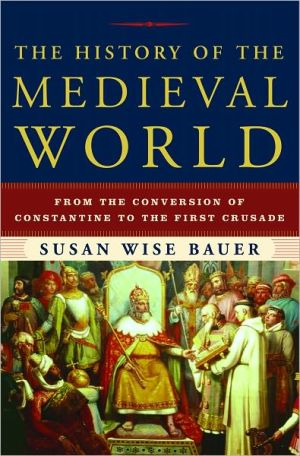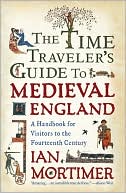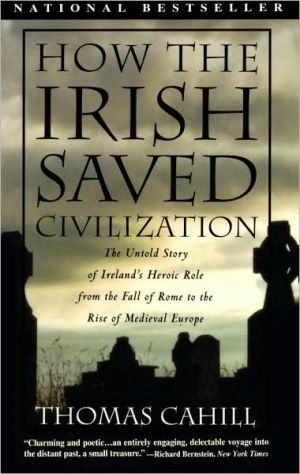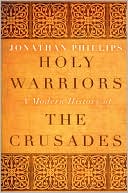The History of the Medieval World: From the Conversion of Constantine to the First Crusade
A masterful narrative of the Middle Ages, when religion became a weapon for kings all over the world.\ From the schism between Rome and Constantinople to the rise of the T’ang Dynasty, from the birth of Muhammad to the crowning of Charlemagne, this erudite book tells the fascinating, often violent story of kings, generals, and the peoples they ruled.\ In her earlier work, The History of the Ancient World, Susan Wise Bauer wrote of the rise of kingship based on might. But in the years between...
Search in google:
A masterful narrative of the Middle Ages, when religion became a weapon for kings all over the world. Publishers Weekly Bauer (The History of the Ancient World) continues her witty and well-written examination of world history with a volume that is rich in detail and intriguing in anecdotal information. In describing dramatic events (such as the worldwide –impact of the eruption of Krakatoa in 535 C.E., or civil war among the descendants of Charlemagne), near-legendary individuals (like the great general turned mercenary El Cid), and decisive historical movements from the fourth century C.E. to the beginnings of the 12th century, attention is effectively paid not only to western and eastern Europe but to North Africa, the Middle East, Central Asia, the Far East, South Asia, and the Americas. The political and military rise and fall of rulers or would-be rulers and the prominence of religion in matters of conscience and state give force and power to the narrative as does the constant impact of simple human emotion and ambition on the flow of history. A bit overwhelming in its scope, Bauer’s work nevertheless proves perfectly, and entertainingly, that the “more things change, the more they stay the same.” 20 illus., 85 maps. (Feb.)
List of MapsList of IllustrationsPt. 1 Unity 11 One Empire, Under God: The Roman empire, 312-330 32 Seeking the Mandate of Heaven: China, 313-402 133 An Empire of the Mind: India, 319-415 214 The Persian Threat: The Roman empire, the Persian empire, eastern Africa, and Arabia, 325-361 285 The Apostate: The Roman empire and the Persian empire, 361-364 366 Earthquake and Invasion: The Roman empire, the islands of Britain, and the Germanic territories, 364-376 417 Refounding the Kingdom: The kingdoms of Goguryeo, Baekje, and Silla, 371-412 518 The Catholic Church: The Roman empire, 378-382 56Pt. 2 Fractures 619 Excommunicated: The Roman empire, the islands of Britain, and the Persian empire, 383-392 6310 Cracked in Two: The Roman empire, 392-396 7211 The Sack of Rome: The western Roman empire and the eastern Roman empire, 396-410 7712 One Nature versus Two: The eastern Roman empire and the Persian empire, 408-431 8513 Seeking a Homeland: The western Roman empire and the Germanic territories, 410-418 9114 The Gupta Decline: India, 415-480 9515 Northern Ambitions: China, 420-464 10016 The Huns: The western Roman empire, the eastern Roman empire, the Germanic territories, the lands of the Huns, Hispania, and North Africa, 423-450 10617 Attila: The western Roman empire, the eastern Roman empire, the Germanic territories, and the lands of the Huns, 450-455 11518 Orthodoxy: The eastern Roman empire and the Persian empire, 451-454 12019 The High Kings: The islands of Britain, 451-470 12520 The End of the Roman Myth: The western Roman empire andthe Germanic territories, 454-476 132Pt. 3 New Powers 14121 The Ostrogoths: The eastern Roman empire and Italy, 457-493 14322 Byzantium: The eastern Roman empire and the Persian empire, 471-518 15023 Aspirations: China and the kingdoms of Goguryeo, Baekje, and Silla, 471-527 15924 Resentment: China, 479-534 16525 Elected Kings: The kingdoms of the Franks, the Visigoths, the Vandals, the Ostrogoths, and the British, 481-531 17226 Invasion and Eruption: India and the southeastern islands of Sumatra and Java, 497-535 18027 The Americas: Mesoamerica, c. 500-600 18628 Great and Holy Majesty: Eastern Africa, Arabia, the Persian empire, and the Byzantine empire, 510-529 19329 Pestilence: The Persian empire, the Byzantine empire, North Africa, and Italy, 532-544 20330 The Heavenly Sovereign: The kingdoms of Goguryeo, Baekje, Silla, and Yamato Japan, 536-602 21531 Reunification: China and Goguryeo, 546-612 22332 The South Indian Kings: India, 543-620 23133 Two Emperors: Italy, the kingdom of the Visigoths, the eastern Roman empire, the Persian empire, and Arabia, 551-579 23734 The Mayors of the Palaces: The kingdom of the Franks, 558-656 24635 Gregory the Great: Italy and the islands of Britain, 572-604 25536 The Persian Crusade: The eastern Roman empire, the Persian empire, and various kingdoms of Slavs, Bulgars, Avars, and Khazars, 589-632 26137 The Prophet: Arabia, 590-622 27338 Tang Dominance: China, Japan, the Turkish Khaghanates, and the kingdoms of Tibet, Baekje, Goguryeo, and Silla, 622-676 28238 The Tribe of Faith: Arabia, 622-642 29140 Intersection: India and Sri Lanka, 640-684 30241 The Troubles of Empire: Arabia, 643-661 307Pt. 4 States and Kingdoms 31742 Law and Language: Italy, the Byzantine empire, the First Bulgarian Empire, and the empire of the Umayyad caliphs, 643-702 31943 Creating the Past: Japan, 661-714 32744 The Days of the Empress: China, the kingdom of Tibet, and the Eastern Turkish Khaghanate, 683-712 33345 Paths into Europe: The Byzantine empire, the Umayyad caliphate, the kingdoms of the Khazars, Bulgarians, and Visigoths, and the lands of the Franks, 705-732 34146 The Kailasa of the South: The Umayyad caliphate and India, 712-780 35147 Purifications: The Umayyad caliphate, the Byzantine empire, and Italy, 718-741 35748 The Abbasids: The Umayyad caliphate, the kingdom of the Khazars, and al-Andalus, 724-763 36349 Charlemagne: Italy, the kingdom of the Franks, the lands of the Saxons, and al-Andalus, 737-778 37150 The An Lushan Rebellion: China, the nomadic north, and the kingdoms of Tibet, Nanzhao, Balhae, and Unified Silla, 751-779 38051 Imperator et Augustus: The Byzantine and Abbasid empires, the First Bulgarian Empire, Italy, and the kingdom of the Franks, 775-802 38752 The New Sennacherib: The Byzantine and Abbasid empires, the First Bulgarian Empire, and the kingdom of the Franks, 786-814 39653 Castle Lords and Regents: Silla and Japan, 790-872 40554 The Triumph of the Outsiders: China and Silla, 806-918 41355 The Third Dynasty: The Abbasid empire, 809-833 42356 The Vikings: The kingdoms of the Franks, the Byzantine empire, al-Andalus, and the lands of the Rus, 813-862 42757 Long-Lived Kings: India and the southeastern islands of Sumatra and Java, 814-900 43758 Foreign and Domestic Relations: The Byzantine empire, the kingdom of Louis the German, Moravia, and Bulgaria, 856-886 44259 The Second Caliphate: The Abbasid empire and North Africa, 861-909 45060 The Great Army of the Vikings: The islands of Britain, 865-878 45861 Struggle for the Iron Crown: Italy and the kingdoms of the Franks, 875-899 46662 Kampaku: Japan, 884-940 47263 Basileus: The Byzantine and Bulgarian empires, 886-927 47964 The Creation of Normandy: Italy and Western Francia, 902-911 48865 The Kingdom of Germany: Eastern Francia and Bohemia, 907-935 49266 The Turn of the Wheel: India and Sri Lanka, 907-997 49867 The Capture of Baghdad: Al-Andalus, the Abbasid and Fatimid caliphates, and the dynasties to the east of Baghdad, 912-945 50468 Three Kingdoms: Goryeo and China, 918-979 51169 Kings of England: The Scandinavian kingdoms and the islands of Britain, 924-1002 51870 The Baptism of the Rus: The Byzantine empire, Bulgaria, and the lands of the Rus, 944-988 530Pt. 5 Crusades 53971 The Holy Roman Emperor: Germany, Italy, and Western Francia, 950-996 54172 The Hardship of Sacred War: India, Sri Lanka, Srivijaya, and the dynasties east of Baghdad, 963-1044 55073 Basil the Bulgar-Slayer: The Byzantine, Abbasid, and Fatimid empires, Bulgaria, and the Rus, 976-1025 56074 Defending the Mandate: China, 979-1033 56875 The New Found Land: Greenland and the Americas, 985-1050 57476 Schism: Germany, Italy, Hungary, and the Byzantine empire, 1002-1059 58477 Danish Domination: England, Scotland, the Scandinavian kingdoms, Hungary, and Normandy, 1014-1042 59678 The Norman Conquest: England, Norway, and Normandy, 1042-1066 60479 The Kings of Spain: Spain and North Africa, 1016-1108 61380 The Arrival of the Turks: The Byzantine empire and the lands of the Turks, 1025-1071 62581 The Loss of the Song: China, Goryeo, and the peoples to the north and west, 1032-1172 63482 Repentance at Canossa: Germany, Western Francia, and Italy, 1060-1076 64183 The Call: The Byzantine empire, Italy, Germany, and the lands of the Turks, 1071-1095 64884 Fighting for Jerusalem: The Byzantine empire and the lands of the Turks, 1095-1099 65685 Aftershocks: Spain and Jerusalem, 1118-1129 664Notes 669Works Cited 703Permissions 719Index 721
\ Publishers WeeklyBauer (The History of the Ancient World) continues her witty and well-written examination of world history with a volume that is rich in detail and intriguing in anecdotal information. In describing dramatic events (such as the worldwide –impact of the eruption of Krakatoa in 535 C.E., or civil war among the descendants of Charlemagne), near-legendary individuals (like the great general turned mercenary El Cid), and decisive historical movements from the fourth century C.E. to the beginnings of the 12th century, attention is effectively paid not only to western and eastern Europe but to North Africa, the Middle East, Central Asia, the Far East, South Asia, and the Americas. The political and military rise and fall of rulers or would-be rulers and the prominence of religion in matters of conscience and state give force and power to the narrative as does the constant impact of simple human emotion and ambition on the flow of history. A bit overwhelming in its scope, Bauer’s work nevertheless proves perfectly, and entertainingly, that the “more things change, the more they stay the same.” 20 illus., 85 maps. (Feb.)\ \ \ \ \ From the Publisher"[A] witty and well-written examination of world history...that is rich in detail and intriguing in anecdotal information." —-Publishers Weekly\ \







